Aldebaran is the brightest star in the zodiac constellation Taurus. It is the fourteenth-brightest star in the night sky and it is believed to host a planet nicknamed Aldebaran b.
Key Facts & Summary
- Aldebaran is a red giant star of spectral type K5+ III and it is around 65 light-years / 20 parsecs away from the Sun.
- The star varies slowly in brightness between magnitude 0.75 and 0.95. This cannot be seen through the naked eye though. Thus Aldebaran is a slightly variable star assigned to the low irregular type LB.
- Aldebaran hosts a star named Aldebaran b which is several times the mass of Jupiter.
- Aldebaran is over 400 times as luminous as our sun, but it is way cooler. It has a surface temperature of 3.900 degrees Kelvin.
- It has a radius of about 44 times that of the sun.
- Aldebaran completes a rotation in about 520 days.
- The star has a surface gravity of 1.59 cgs – around 25 times lower than Earth’s and 700 times lower than the suns.
- Aldebaran is around 17% more massive than our sun and it has around 30% less metallicity than it.
- Aldebaran has a diameter of around 61 million kilometers / 37.9 million miles.
- Aldebaran has a magnetic field strength of around 0.22 Gauss.
- The probe Pioneer 10 is headed towards the general direction of Aldebaran. Though it isn’t powered or in contact with Earth anymore, it will reach the star in around 2 million years.
- Aldebaran is around 6.4 billion years old – much older than our sun. Its origins are unknown since it isn’t associated with any asterism, structure, cloud, or group of stars.
- Since the star is 5.47 degrees south of the ecliptic, it can be occulted by our Moon.
- Due to its position in the sky, Aldebaran is sometimes called the Eye of Taurus.
Since the star is visible to the naked eye, many cultures and civilizations have recorded Aldebaran and attributed the star with many different myths and religious symbolism.
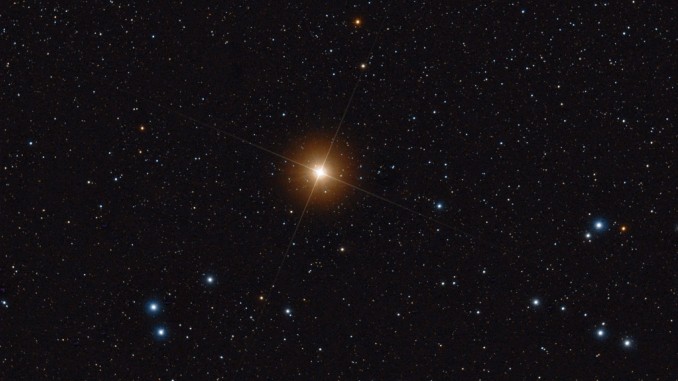
Its name comes from Arabic, and it translates to “the follower”. It has been named as such since the star appears to follow the Pleiades cluster/Messier 45, in the sky.
Aldebaran has evolved off the main sequence stage of its life and exhausted its supply of hydrogen fuel in its core. Because of this, the star has brightened and expanded its radius.
Formation
The origin of Aldebaran is still a mystery to scientists. It is speculated that it formed around 6.4 billion years ago, but the star doesn’t appear to be linked with any star group, structure or cloud. Its origins remain unknown to this day.
Distance, Size, and Mass
Aldebaran is around 65 light-years / 20 parsecs away from the Sun. Since it’s evolved off the main sequence of stars, Aldebaran has reached greater proportions and luminosities.
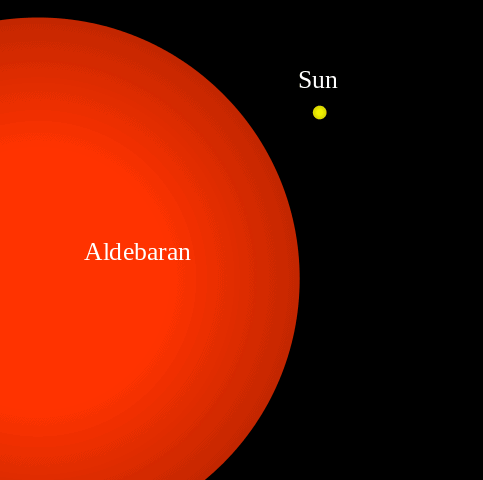
Aldebaran currently has a diameter of around 61 million kilometers / 37.9 million miles, and a radius of about 30.7 million kilometers / 19 million miles. It is thus around 44 times bigger than our sun.
Though it is much bigger than our sun, it has only 1.7 solar masses. Thus it is just 17% more massive than the sun.
Other Characteristics
Aldebaran’s visual magnitude varies from 0.75 to 0.95. This small variability cannot be seen with the naked eye, but it puts Aldebaran in the low irregular type LB stars.
Since its core collapsed into a degenerate helium core, it has ignited a shell of hydrogen outside its core. Aldebaran is losing its mass at about one entire Earth per 300.000 years with a velocity of 30 km / 18.6 mi per second.
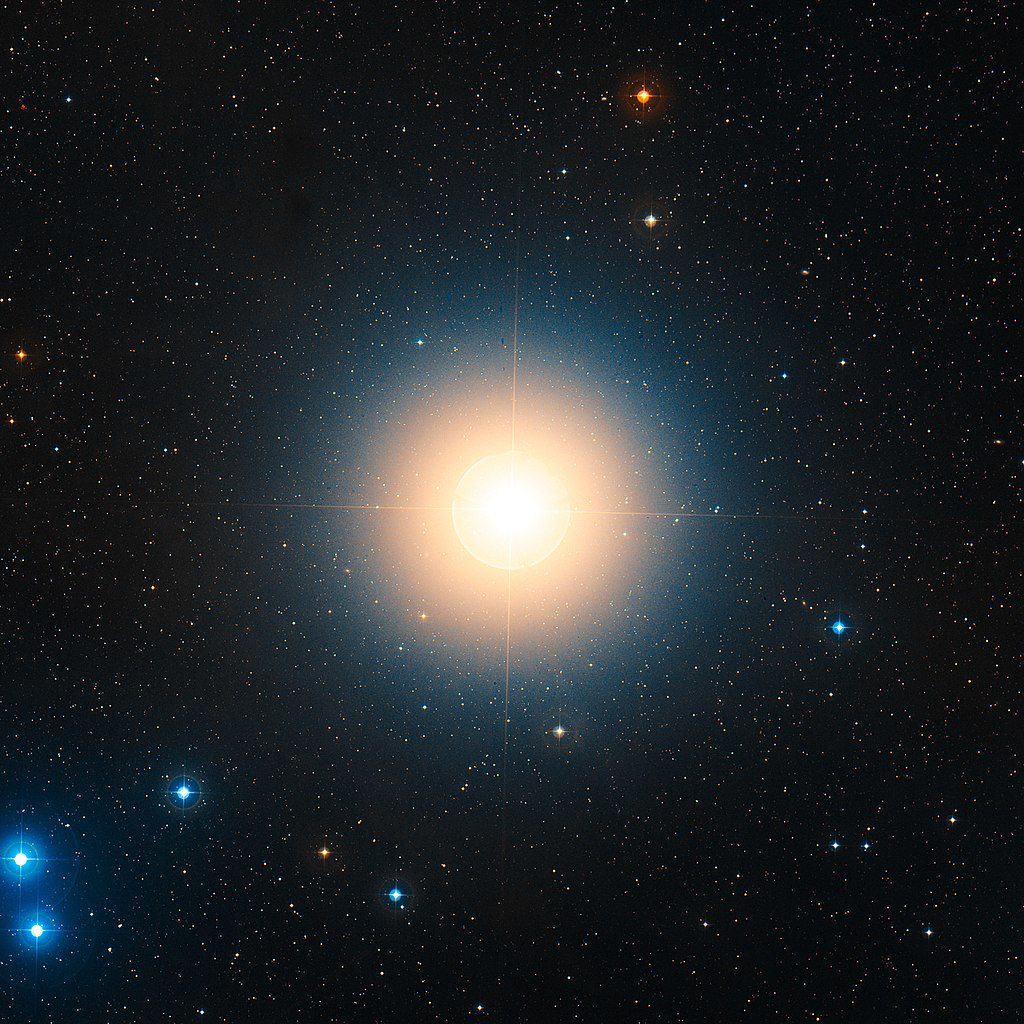
This creates an extended molecular outer atmosphere where the temperatures are cool enough for molecules of gas to form. This region is 2.5 times the stars radius away – 1 AU – and has a temperature of around 1.500 degrees K.
Outside this sphere, its stellar winds continue to expand forming a roughly spherical astrosphere of around 1.000 AU, centered on Aldebaran.
Planetary System
It is rumored that Aldebaran has an exoplanet named Aldebaran b. This planet is supposed to be several times bigger than Jupiter. The exoplanet’s existence was speculated since 1993 but only in 2015 more evidence seems to back up this claim.

In 2019 however, more arduous observations and analysis put the existence of the exoplanet in serious doubt. It is now suggested that in order for the data to be accurate, Aldebaran would need to have 2 exoplanets or none at all. Observations still continue to this day in order to end this dispute.
Location & Visual Companions
Aldebaran is located in the constellation of Taurus. It is the brightest star in the constellation and appears to be part of the Hyades cluster when viewed from Earth.
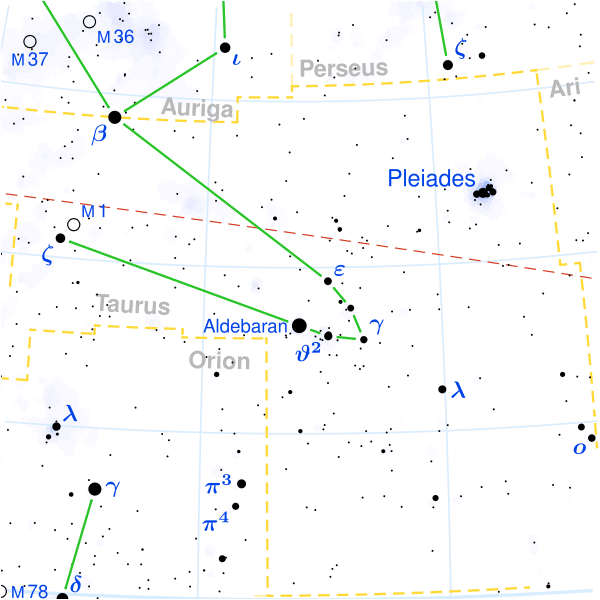
Though it appears to be part of the Hyades cluster, modern measurements show that it is actually in a different region of space. The Hyades cluster is around 60 light-years farther away from Aldebaran.
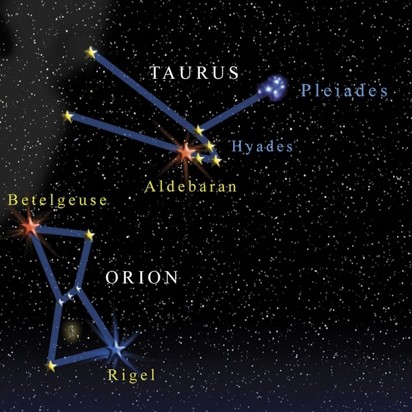
The Taurus constellation is one of the oldest documented constellations. Its origins stretch back at least as far as the Bronze Age.
Aldebaran seems to have five faint stars which appear close to it. Analysis suggests that these stars are not bound to Aldebaran but some of them are binary stars.
The Future
Though the Pioneer 10 probe is set on a route towards Aldebaran, it will reach the star in around 2 million years. Before this, the star will continue to expand in size and luminosity and eventually, it will become a full-fledged red giant that will be over 500 times as bright as the sun.
Did you know?
• Aldebaran is the third red giant star closest to us. The star’s rising marked the beginning of the Babylonian New Year.
• Around 5.000 years ago, Aldebaran marked the location of the vernal equinox point, the point in the sky marking the sun’s position on the first day of spring in the northern hemisphere.
• When Aldebaran was aligned as such, 5.000 years ago, it gave rise to a multitude of bull-oriented springtime celebrations, even deities such as Baal, the bullish idol of biblical fame.
• Aldebaran marks the right eye of the celestial Bull. The left eye is marked by the Epsilon Tauri star.
• Aldebaran is in conjunction with the Sun every year on the 1st of June.
• Though Aldebaran is the 14th brightest star in the night sky, it is one of the brightest stars in near-infrared wavelengths with a J band magnitude of -2.1.
• To the ancient Persians, Aldebaran was one of the Four Royal Stars. It was known to them as Tascheter. Other cultures saw it as Buddha’s Star, God’s Eye, or the Star of Illumination.
• Though it is commonly referred to as the eye of the bull, in the Middle Ages the star was called Cor Tauri – the heart of the bull.
• Taking into account the Pleiades cluster, the Seris people in Mexico saw Aldebaran as a star providing light for seven women giving birth.
• When it comes to more modern influences, Aldebaran is believed to have inspired the name of Princess Leia’s home planet, Alderaan – which was destroyed by the Death Star in Star Wars.
• Awkwardly, Aldebaran is featured in many conspiracy theories regarding aliens often linked to Nazi UFOs. The German conspiracy theorist Axel Stoll considered the star the home of the Aryan race and the target of expeditions by the Wehrmacht.
Sources:
Image source:
- http://www.astronomytrek.com/wp-content/uploads/2017/04/Aldebaran.jpg
- https://upload.wikimedia.org/wikipedia/commons/thumb/4/45/Aldebaran-Sun_comparison-en.svg/483px-Aldebaran-Sun_comparison-en.svg.png
- https://www.star-facts.com/wp-content/uploads/2019/10/Aldebaran-star.jpg?189db0&189db0
- https://en.wikipedia.org/wiki/Aldebaran_b#/media/File:Aldebaran_b_exoplanet.jpg
- https://upload.wikimedia.org/wikipedia/commons/thumb/3/31/Taurus_constellation_map.svg/600px-Taurus_constellation_map.svg.png
- http://www.astronomytrek.com/wp-content/uploads/2017/04/Aldebaran-in-Taurus-Constellation.jpg
